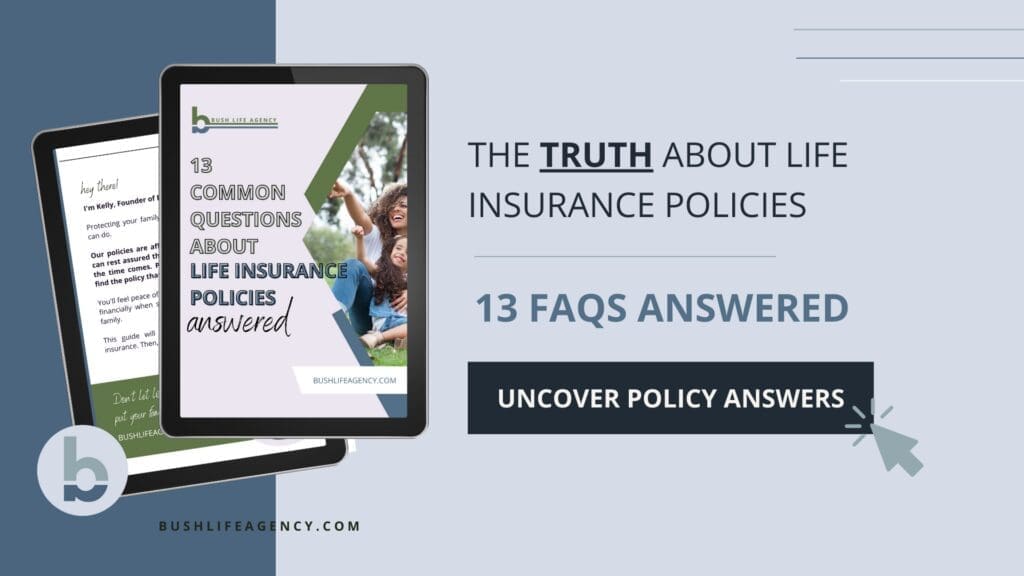Many types of life insurance policies are available, and it can be confusing to determine which one is best suited for your family’s needs. Understanding the differences life insurance types is crucial in making an informed decision. This post will help explain some of the most common types of life insurance policies, what they cover, and how they can provide financial security for your loved ones in the event of unforeseen circumstances. Whether you’re looking for term life insurance, whole life insurance, or universal life insurance, having a clear understanding will assist you in selecting the right policy to protect your family’s future.
Table of Contents
1. Term Life Insurance
Term life insurance is the most popular type of life insurance policy.
Term life insurance provides coverage for a specific period, usually 10-30 years. If you die while the policy is in force (when you’re paying premiums), your beneficiary receives a death benefit.
If you reach the end of your coverage period, you and the insurance company simply part ways. If you still need life insurance, you can extend coverage for a new term or convert your policy to permanent life insurance ( keep in mind your premiums might increase).
Some Term Life Insurance policies come with a return of premium option. At the end of your term policy, if you are still alive, you receive every premium you have paid over the 20 or 30 years back in a lump sum.
2. Permanent Life Insurance
Permanent life insurance offers guaranteed coverage and is sometimes broken down into a universal or whole life policy.
Universal Life Insurance
Universal life insurance is an affordable permanent life insurance option with coverage that lasts a lifetime. Universal life insurance is popular for its affordability compared to other permanent life insurance options and its adjustable benefits and cash value component.
While Life Insurance
Unlike term life insurance, whole life insurance provides coverage for the entire lifetime of the policyholder as long as premiums are paid on time. Whole life insurance is a slightly more expensive type of permanent life insurance policy that provides fixed premiums throughout the policy’s life, and coverage lasts until you die.
All permanent life insurance policies provide coverage for a lifetime.
These policies also offer flexibility on premium payments and adjustments to policy terms. Many people opt for universal life because it has a cash value component that accumulates throughout the entire life of the policy. If you miss a payment, the cash value can step in and keep your policy active.
3. Mortgage Protection Insurance
Mortgage protection is a type of term life insurance designed to cover your mortgage payments if you pass away while the policy is in force. For most people, their home is their most valuable asset, so this insurance ensures that their loved ones can stay in the home rather than face financial hardship if the primary breadwinner is no longer around to help pay the bills.
Many mortgage protection policies offer coverage if the homeowner becomes disabled or receives a critical illness diagnosis.
For most people, their home is their most valuable asset, so this insurance ensures that their loved ones can stay in the home rather than face financial hardship if the primary breadwinner is no longer around to help pay the bills.
Bush Life Agency
4. Critical Illness Insurance
Protecting your future is important, and with life’s uncertainties, protecting against a work-related disability or a critical illness diagnosis can provide peace of mind and financial security for your loved ones.
Critical illness insurance is one of the life insurance types that pays a lump sum benefit if you are diagnosed with a condition listed in the policy terms. You get to choose how you spend the money: it can cover medical expenses, exploratory treatments, make up for lost income, and more.
5. Final Expense Insurance
Final expense insurance is a type of permanent life insurance policy that provides a lump sum to your chosen beneficiary to cover end-of-life expenses. If you buy final expense insurance and continue to pay premiums during the life of the policy, your beneficiary will receive the death benefit when you die.
They can use the death benefit to cover costs related to your passing, including medical expenses, a memorial, or a funeral service.
Many families don’t have the funds readily available to cover funeral expenses, which generally cost around $10,000. Final expense insurance steps in to pay for the burial and any other expenses your family needs, so they don’t have to face a financial burden during a difficult time.
Recap: Life Insurance Types Explained
There are many different types of life insurance policies available, and it can be confusing to know which one is best for your family. Choosing the right life insurance policy for your family is an important decision. When selecting an insurance policy for your family, it’s important to consider your needs and budget. There is no one-size-fits-all solution. Contact Kelly for a free quote and find the right policy for you and your family.





